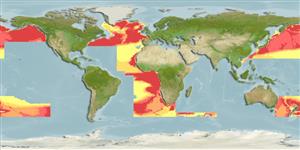>
Notacanthiformes (Halosaurs and deep-sea spiny eels) >
Notacanthidae (Deep-sea spiny eels)
Etymology: Polyacanthonotus: Greek, poly = a lot of + Greek, akantha = thorn + Greek,noton = back (Ref. 45335); challengeri: Named after the H.M.S. Challenger (Ref. 6885).
More on author: Vaillant.
Environment: milieu / climate zone / depth range / distribution range
Écologie
marin bathypélagique; profondeur 777 - 4560 m (Ref. 50610), usually 2000 - 3000 m (Ref. 6728). Deep-water; - 50°S
North Pacific: Japan, Bering Sea and British Columbia, Canada (Ref. 6885), also south to Oregon, USA (Ref. 35578). South Pacific: known form one specimen collected near New Zealand. Southeast Atlantic: South Africa. Southern Ocean: known from one specimen collected near the Kerguelen Islands. Mainly antitropical (Ref. 5165) but reported from Azores, Canary Islands and Morocco (Ref. 6728).
Taille / Poids / Âge
Maturity: Lm ? range ? - ? cm
Max length : 60.0 cm TL mâle / non sexé; (Ref. )
Épines dorsales (Total) : 32 - 35; Rayons mous dorsaux (Total) : 0; Vertèbres: 242 - 244. Caudal fin very small; anal fin with 161-162 rays altogether, 26-35 of which are spines, long, low, confluent with caudal; pectorals with a fleshy base (Ref. 6885). Cream to faintly pink, possibly with light brown markings; black on posterior margins of anal and caudal fins; black on posterior edge of gill cover, lining of mouth and gill chamber, and parts of peritoneum (Ref. 6885).
Feeds on benthic invertebrates, especially amphipods, polychaetes and mysids (Ref. 6728).
Life cycle and mating behavior
Maturities | Reproduction | Spawnings | Egg(s) | Fecundities | Larves
Gon, O., 1990. Notacanthidae. p. 100-101. In O. Gon and P.C. Heemstra (eds.) Fishes of the Southern Ocean. J.L.B. Smith Institute of Ichthyology, Grahamstown, South Africa. (Ref. 5165)
Statut dans la liste rouge de l'IUCN (Ref. 130435)
Menace pour l'homme
Harmless
Utilisations par l'homme
Outils
Articles particuliers
Télécharger en XML
Sources Internet
Estimates based on models
Preferred temperature (Ref.
123201): 1.5 - 3.4, mean 2.4 °C (based on 2854 cells).
Phylogenetic diversity index (Ref.
82804): PD
50 = 0.5630 [Uniqueness, from 0.5 = low to 2.0 = high].
Bayesian length-weight: a=0.00102 (0.00046 - 0.00225), b=3.06 (2.88 - 3.24), in cm total length, based on all LWR estimates for this body shape (Ref.
93245).
Niveau trophique (Ref.
69278): 3.2 ±0.42 se; based on food items.
Résilience (Ref.
120179): Faible, temps minimum de doublement de population : 4,5 à 14 années (Assuming tmax>10).
Fishing Vulnerability (Ref.
59153): Moderate vulnerability (44 of 100).
